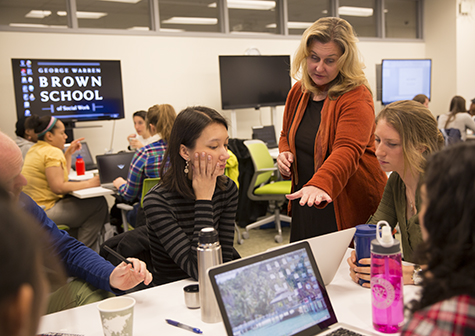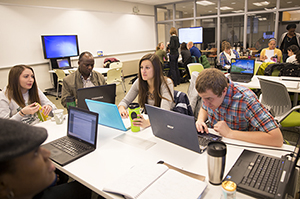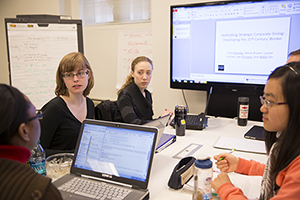
For the first half of the second semester, Room 37 in Goldfarb Hall was a normal, seminar-style classroom: tables and chairs in a “u-shaped” configuration; a podium in front of a whiteboard; and an instructor’s podium.
But over spring break at Washington University in St. Louis, Goldfarb 37 was transformed. For eight weeks, Brown School students in 15 courses took part in an experiment in pedagogy that brings teaching — and learning — into a new era.
This isn’t your parents’ lecture hall. Say hello to the wired world of interactive instruction — or active learning.
Goldfarb 37 is now a classroom with six tables arranged to encourage student interaction with each other instead of focusing on a podium. Six flatscreen monitors and laptop hookups are arranged around the room so students can project and share their work. Tables have chairs that easily can roll from station to station or be turned to join the larger group. These types of furnishings and technology facilitate active learning as juxtaposed to more passive learning, reflective of the prior room arrangement.

“We are treating this as a research experiment,” said Amanda Moore McBride, PhD, associate dean of the Brown School, who is principal investigator for the study and who teaches “Social Work Practice with Organizations and Communities,” a core course in the Master of Social Work program, in this classroom.
“As a teacher, I like to work the room,” she said. “This setup enables me to facilitate the learning process, where I can interact with individual students, any of the six groups, or the entire classroom at any given time with fluidity and ease.”
While student groups are busy preparing presentations and papers, McBride and her teaching assistant walk among them, listening to their processes, answering questions and offering advice.
“If I hear a common theme or question that needs answering, I can stop the work that’s going on and say to the class, ‘This is the issue I’m hearing, here is how you might approach it,’ ” she said.
On a late-April morning just two weeks before finals, students in McBride’s class were working together preparing their end-of-the-year project that would culminate in a public multimedia presentation.
“This is unlike any of our other classrooms,” said Karen Lawrence, a first-year master of social work student working with four classmates.
“This class involves a semester-long group project. It was very difficult to interact in groups before, but this new arrangement enables us to bring our individual work together — including our group’s 50-page paper — and then collaborate and discuss it as we go along.”

McBride said every component of the active learning classroom is being evaluated — types of chairs, types of tables, even the technology — through surveys and focus groups with the faculty and students who have taught and learned in this space.
The Brown School intends to use the research to inform its classroom design.
“This project represents the Brown School’s commitment to professional graduate-level training,” McBride said, “where we are creating learning environments and applying active learning pedagogies that will develop the problem-solving competencies of our public health and social work graduates.”